Structural Engineering
Improving Sustainability
The Structural Engineering group seeks to develop and implement materials and structures that improve the sustainability and resiliency of infrastructure systems through experimental, theoretical, and computational research. To achieve this objective, the Structural Engineering group offers graduate instruction and research in advanced analysis techniques, long-term and structural health monitoring, design with traditional and non-traditional materials, design for natural hazards, engineering mechanics, and risk and reliability.
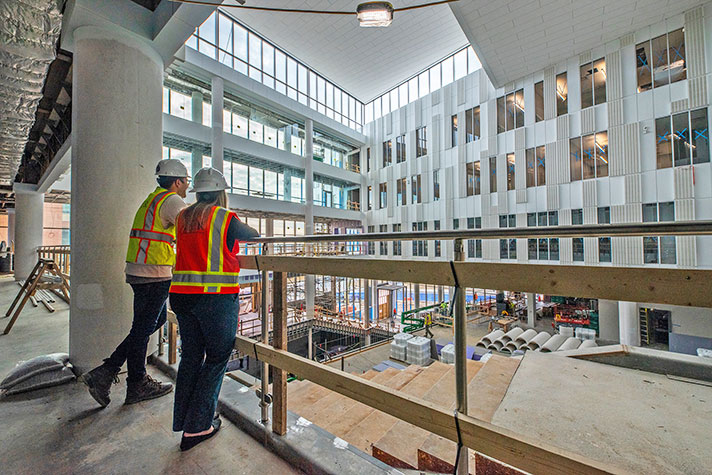
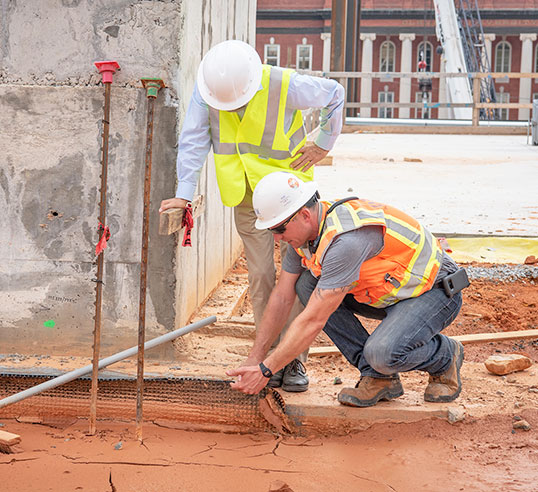
Graduate Studies
The Structural Engineering graduate program at Clemson University offers Master of Science and Doctor of Philosophy degrees in Civil Engineering. The program's objective is to provide a well-balanced education in structural analysis and design and theoretical and practical aspects of Civil Engineering.
Through the graduate-level courses offered within the department, students learn classical structural mechanics and behavior of engineering materials, explore modern computational techniques, recognize the uncertainties and errors in calculations and gain hands-on experiences through laboratory/field testing to prepare for a consulting or research career path. Students are also encouraged to explore supporting and complementary courses offered in other Civil Engineering disciplines and other departments at Clemson University.
Structural Engineering Research
Research in structural engineering within the Glenn Department of Civil Engineering often focuses on bridges and buildings and how they can be modified to fit current needs. Particular areas include structural behavior, solid mechanics, materials, structural designs, and computational mechanics.
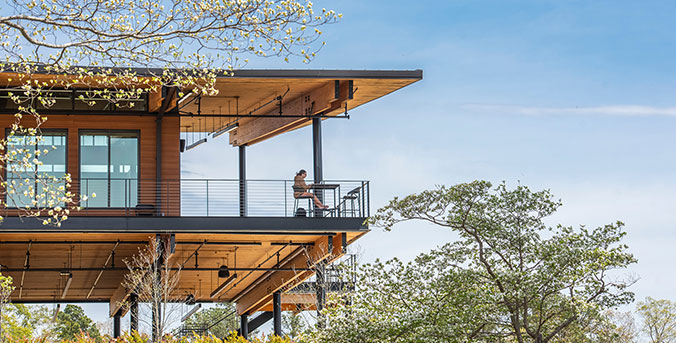
Material Innovation
The new Snow Family Outdoor Fitness and Wellness Center is built with cross-laminated timber. It's among the first-ever projects involving cross-laminated timber made from southern yellow pine. Mass timber is an environmentally sustainable alternative to steel and concrete and is made of wood panels usually held together by glue, nails or dowels. Advocates said it allows for fast construction and requires fewer fossil fuels than other building materials while maintaining fire protection and seismic resistance standards.
Jason Leonard is currently researching deployable structures using cross-laminated timber (CLT). Cross-Laminated Timber is a large-scale, prefabricated solid engineered wood panel.
“The goal of my research is to design a structure that can be deployed to meet post-disaster needs. These needs could include housing for those who have been displaced from their homes or medical facilities in areas where hospitals may have reached capacity. Growing up in the coastal area, I witnessed how hurricanes impacted people's lives. I believe this research project could provide better relief to those affected by natural disasters.”
Jayson LeonardGraduate Research Student
Establishing a Resilient Framework
Structural Engineering is the field of civil engineering primarily concerned with structural systems in the built environment. It looks at the "bones" of structures to improve the resiliency of the framework and increase sustainability.
-
Facilities
The facilities are equipped with state-of-the-art equipment and instrumentation to support research activities.
Built Environment Lab (BEL)
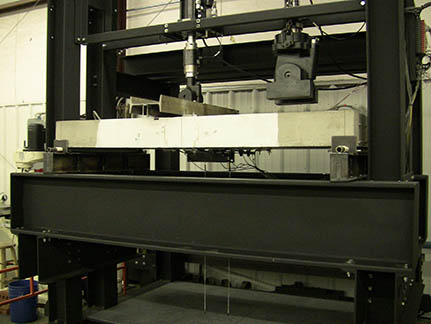 The Built Environment Laboratory (BEL) is a 12,000-square-foot building and is the hub of built environment teaching and research on campus. The focus of BEL is developing efficient building and bridge materials and systems. The Structural testing area (within BEL) is a 60’ by 100’ high bay facility with a 2400 square foot strong floor designed to test large structural members. The lab is equipped with closed-loop hydraulic and screw-driven actuators for applying loads, BRERWULF for applying static and fluctuating air pressures, an air cannon for missile impact studies, a universal test machine for testing small components, and data acquisition equipment to measure and record data (stresses, loads, accelerations and deformations). In addition, the lab serves as the home base for the mobile instrumentation lab for testing highway bridges.
The Built Environment Laboratory (BEL) is a 12,000-square-foot building and is the hub of built environment teaching and research on campus. The focus of BEL is developing efficient building and bridge materials and systems. The Structural testing area (within BEL) is a 60’ by 100’ high bay facility with a 2400 square foot strong floor designed to test large structural members. The lab is equipped with closed-loop hydraulic and screw-driven actuators for applying loads, BRERWULF for applying static and fluctuating air pressures, an air cannon for missile impact studies, a universal test machine for testing small components, and data acquisition equipment to measure and record data (stresses, loads, accelerations and deformations). In addition, the lab serves as the home base for the mobile instrumentation lab for testing highway bridges.Wind Load Test Facility
In addition, the group has access to the Wind Load Test Facility. The WLTF is a 10,000 sf laboratory housing one of the country's largest atmospheric boundary wind tunnels. The WLTF possesses an instrumentation and model shop area, actuators and fabrication workshop used for constructing test specimens.
-
Research
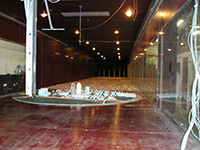 In recent years, structural engineering has become increasingly specialized, and advanced study is required for more exciting and challenging employment opportunities and career advancement. A graduate degree prepares students to meet these increasing challenges. The emphasis of both the teaching and research activities within the Structural Engineering Program provides a good foundation for those individuals intending to pursue careers in design practice, research, or academics.
In recent years, structural engineering has become increasingly specialized, and advanced study is required for more exciting and challenging employment opportunities and career advancement. A graduate degree prepares students to meet these increasing challenges. The emphasis of both the teaching and research activities within the Structural Engineering Program provides a good foundation for those individuals intending to pursue careers in design practice, research, or academics.Focus Areas
- Structural behavior and design, including experimental and numerical analysis for the design of concrete, steel, masonry, wood and fiber-reinforced polymer structures for applications in transportation structures, earthquake engineering, nuclear power plant structures, structural health monitoring, strengthening and repair.
- Solid mechanics, including wave propagation, viscoelastic and viscoplastic constitutive modeling, and multi-scale modeling.
- Materials, including concrete, shale, wood, steel and high-temperature alloys, polymers, composites, welds, nanoscale material characterization, fatigue evaluation, and sensor development.
- Probabilistic approaches in structural design, including seismic fragility assessment, risk assessment and risk-informed design, and reliability-based design.
- Computational mechanics, including finite element analysis, structural dynamics, soil-structure interaction, and analysis of piping, equipment and other non-structural components.
-
People
Miguel Cid Montoya
Wind Engineering, Bridge Engineering, Structural Design, Structural Optimization, Structural Dynamics, Surrogate modeling, Computational Fluid Dynamics, Wind tunnel testing.
Tommy Cousins
Long-term Bridge Monitoring, Behavior of Bridge Structures, Use of High-performance Materials (concrete, steel, composites) in Structures, Prestressed Concrete Structures, Experimental Research
Stephen F. Csernak
Structural Engineering, Wind and Seismic Design, Professional Registration
M. Z. Naser
Engineering for Extreme Conditions, Autonomous and Cognitive Structures, Structural Fire Engineering, Artificial Intelligence, and Material Sciences
W. C. Pang
Structural Reliability, Performance-based Engineering, Structural Dynamics and Earthquake Engineering, Displacement-based Design, Performance of Low and Mid-rise Wood Structures subject to Natural Hazards, Nonlinear Numerical Models for Structures
Laura Redmond
Behavior of Reinforced Concrete and Masonry Structures, Non-linear Modeling of Structures, and Structural Rehabilitation/retrofit Using Additive Manufacturing and Novel Structural Materials
Brandon Ross
Building Adaptation and Design for Adaptability, Experimental Evaluation of Prestressed and Reinforced Concrete, Low-cost Systems for Housing in Developing Communities
Michael Stoner
Mass Timber Performance and Construction, Structural Engineering Education, Retrofits and Structural Performance of Wood Buildings
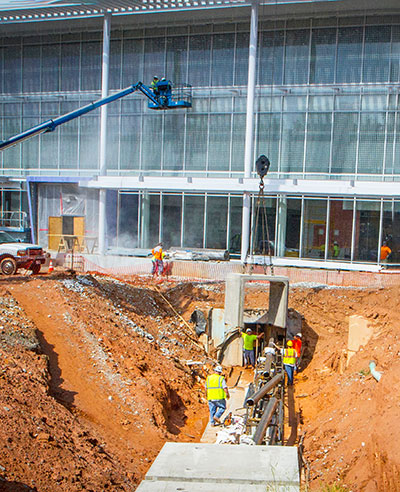
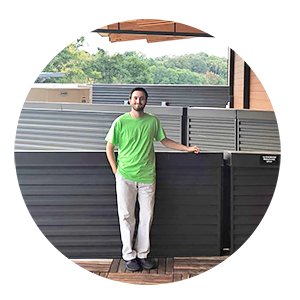
 The Built Environment Laboratory (BEL) is a 12,000-square-foot building and is the hub of built environment teaching and research on campus. The focus of BEL is developing efficient building and bridge materials and systems. The Structural testing area (within BEL) is a 60’ by 100’ high bay facility with a 2400 square foot strong floor designed to test large structural members. The lab is equipped with closed-loop hydraulic and screw-driven actuators for applying loads, BRERWULF for applying static and fluctuating air pressures, an air cannon for missile impact studies, a universal test machine for testing small components, and data acquisition equipment to measure and record data (stresses, loads, accelerations and deformations). In addition, the lab serves as the home base for the mobile instrumentation lab for testing highway bridges.
The Built Environment Laboratory (BEL) is a 12,000-square-foot building and is the hub of built environment teaching and research on campus. The focus of BEL is developing efficient building and bridge materials and systems. The Structural testing area (within BEL) is a 60’ by 100’ high bay facility with a 2400 square foot strong floor designed to test large structural members. The lab is equipped with closed-loop hydraulic and screw-driven actuators for applying loads, BRERWULF for applying static and fluctuating air pressures, an air cannon for missile impact studies, a universal test machine for testing small components, and data acquisition equipment to measure and record data (stresses, loads, accelerations and deformations). In addition, the lab serves as the home base for the mobile instrumentation lab for testing highway bridges. In recent years, structural engineering has become increasingly specialized, and advanced study is required for more exciting and challenging employment opportunities and career advancement. A graduate degree prepares students to meet these increasing challenges. The emphasis of both the teaching and research activities within the Structural Engineering Program provides a good foundation for those individuals intending to pursue careers in design practice, research, or academics.
In recent years, structural engineering has become increasingly specialized, and advanced study is required for more exciting and challenging employment opportunities and career advancement. A graduate degree prepares students to meet these increasing challenges. The emphasis of both the teaching and research activities within the Structural Engineering Program provides a good foundation for those individuals intending to pursue careers in design practice, research, or academics.